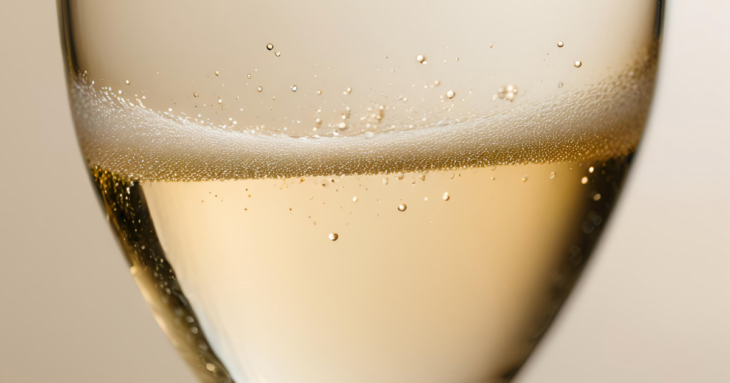The Science Behind Champagne Bubbles: What It Reveals
There’s a certain magic in the moment champagne touches the glass—the elegant rise of bubbles like a golden ballet. Each shimmering column carries with it a sense of anticipation, celebration, and ceremony. Behind this dance is a rich narrative of chemistry, heritage, and sensory delight. We know the experience of champagne isn’t just in the taste—it begins with the bubbles. They are the first impression and the lingering echo of the entire experience.
Bubbles aren’t mere decoration; they define how we experience flavor, how aroma is delivered, and even how we perceive quality. Their movement and texture influence the very essence of what we taste. This phenomenon isn’t random—it’s the result of meticulous craftsmanship honed over centuries. In this guide, we’ll uncork the layers behind what causes champagne to effervesce and how it shapes the palate. From fermentation to glass shape, every detail influences the sparkling story in your glass.
A Brief History of Champagne and Effervescence
Effervescence wasn’t always embraced. The earliest bottles were viewed with suspicion, often considered flawed. The bubbles we now celebrate were once accidents of nature—spontaneous refermentations that puzzled 17th-century winemakers. Much has been mythologized about Dom Pérignon, the monk who refined, rather than invented, this sparkling revolution.
Though he likely tried to rid wine of its fizz, Dom Pérignon inadvertently elevated it by introducing blending techniques that enhanced consistency. Over time, what began as an inconvenience became a sign of luxury. Through centuries, champagne producers transformed effervescence from a mistake into a marvel. The evolution of technique turned a rustic wine into the drink of celebrations.
Key Terms Behind the Bubbles
- Autolysis – The breakdown of dead yeast cells during aging, which enriches flavor and texture and softens bubbles.
- Disgorgement – The removal of yeast sediment from the bottle after secondary fermentation.
- Effervescence – The bubbles and fizzy quality of sparkling wine, especially champagne.
- Lees – The sediment composed of dead yeast cells left over after fermentation.
- Méthode Traditionnelle – A traditional method of sparkling wine production involving secondary fermentation in the bottle.
- Mousse – The creamy texture and sensation of bubbles in the mouth, considered a mark of quality.
- Nucleation Site – A microscopic point in the glass where CO₂ bubbles begin to form.
- Riddling – A process that slowly tilts and rotates bottles to collect sediment in the neck.
- Secondary Fermentation – A second round of fermentation inside the bottle that generates CO₂, creating bubbles.
- Tulip Glass – A glass shape ideal for champagne, designed to capture aroma while preserving effervescence.
The Chemistry of Champagne Bubbles: What Causes Them?
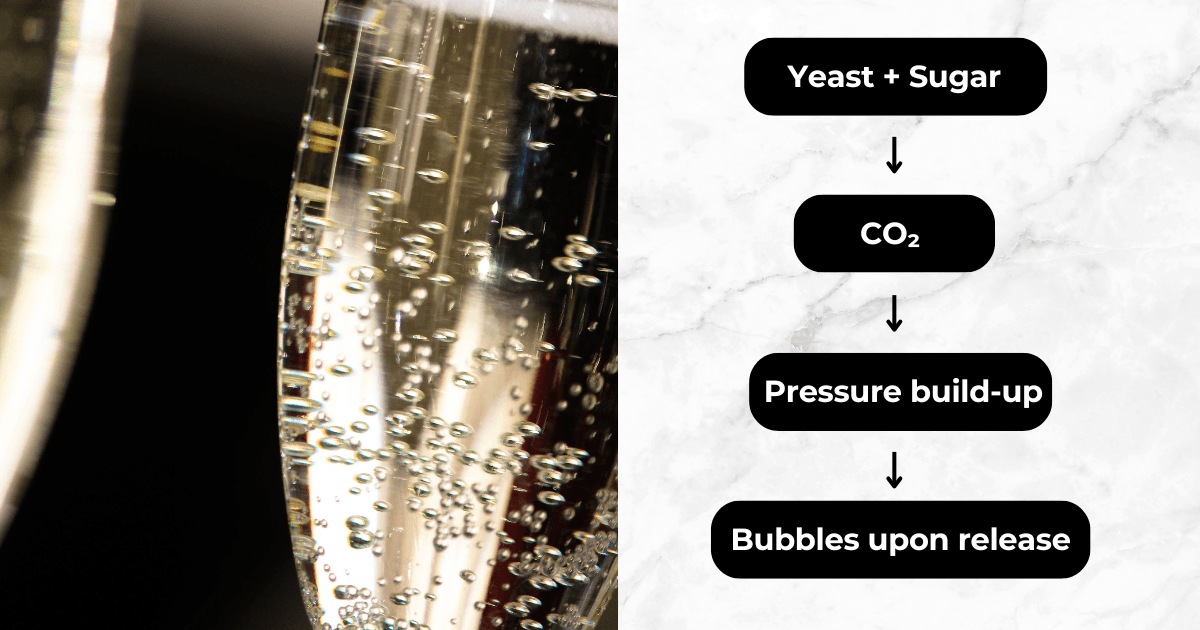
At the heart of every bubble is fermentation. The first transformation takes place in stainless steel vats or oak barrels, where natural grape sugars are converted into alcohol during the primary fermentation. But the real enchantment begins with the second fermentation, which occurs inside sealed bottles—a technique known as the méthode traditionnelle. Here, a carefully measured mixture of sugar and yeast is added, initiating a secondary fermentation that produces carbon dioxide.
With the bottle sealed, the CO₂ cannot escape, so it dissolves into the liquid under pressure, creating a kind of suspended anticipation. Over time, the champagne becomes saturated with CO₂, building pressure equivalent to five to six times that of the Earth’s atmosphere. When the bottle is eventually opened, that trapped gas seeks release, forming bubbles as it escapes. But the story doesn’t end there—these bubbles are shaped by physics and nuance.
After fermentation, the bottles undergo riddling (gradual rotation to collect yeast sediment in the neck) and disgorgement (removal of the sediment). These steps are crucial to preserving the clarity and finesse of the final product. Yet the way bubbles emerge when poured has as much to do with glass as with wine. Invisible to the naked eye, tiny imperfections—microscopic scratches, bits of dust, or residue—act as nucleation sites. These minuscule flaws are the hidden architects of effervescence, offering the CO₂ a pathway to transform into the rising beads we see in every elegant pour.
The Bubble Lifecycle: From Bottle to Glass
Opening a champagne bottle is a release of tension, a theatrical moment when pressure and anticipation meet. That signature hiss signals the awakening of millions of bubbles. Pouring slowly down the side of the glass encourages a graceful formation of columns that rise steadily. But how they behave depends heavily on the glass they meet.
The coupe, elegant yet shallow, lets bubbles escape in quick bursts. The flute preserves effervescence but limits aroma. The tulip strikes the perfect balance—capturing scent while extending the journey of each bubble. As bubbles burst at the surface, they release aromatic compounds, enhancing not just what we taste, but what we feel.
What Bubble Size Really Says About Quality
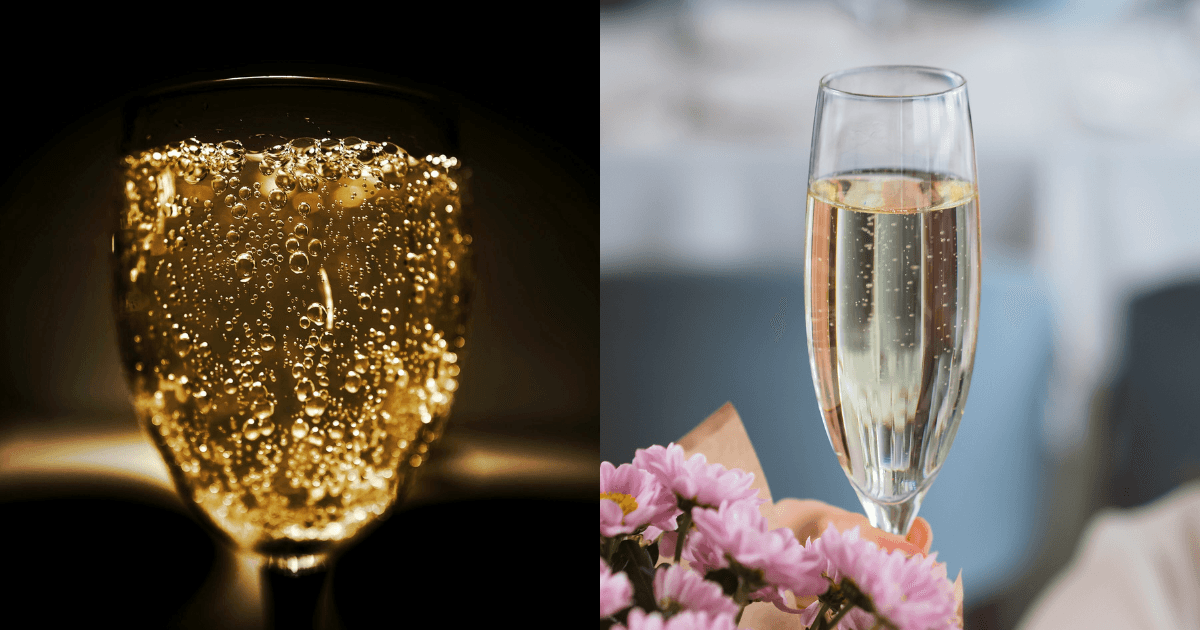
Smaller bubbles have long been seen as the hallmark of fine champagne. Their delicacy offers a smoother mouthfeel and suggests prolonged aging on the lees. Mass-market bottles, by contrast, often show larger, frothier bubbles that dissipate quickly. These differences aren’t just cosmetic—they reflect choices made in fermentation and aging.
But there’s more than meets the eye. According to Brown University, bubble size is influenced by pressure, temperature, bottle aging, and even glass shape. Wines aged for longer periods under controlled conditions tend to produce bubbles that are not only smaller, but also rise in a more consistent and elegant stream. Interestingly, larger bubbles are sometimes better at delivering aromatic intensity due to their greater surface tension and bursting power.
So, the relationship between bubble size and quality isn’t strictly binary. It’s not a question of small versus large—it’s about the elegance, uniformity, and longevity of the effervescence. Truly great champagnes create a textured, continuous mousse that enhances both aroma and taste, forming a bridge between scientific precision and sensory delight.
How Champagne Bubbles Affect Taste and Aroma
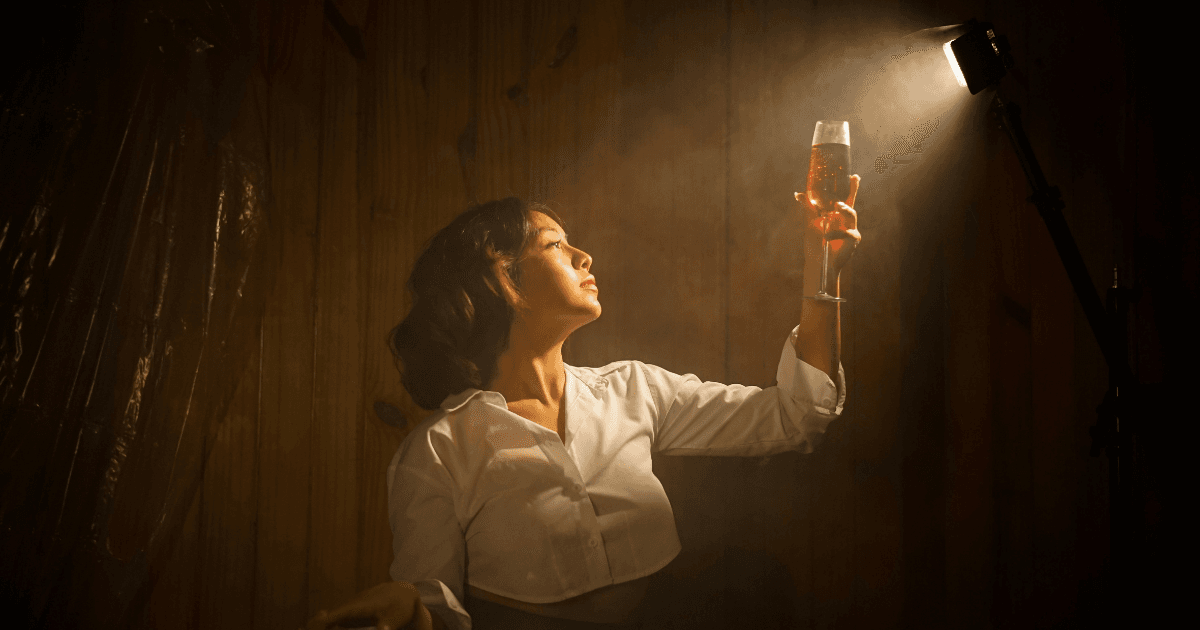
Bubbles are the sensory couriers of champagne—they do more than tickle the tongue. As they rise and burst, they carry volatile aroma compounds directly to the nose, forming a fragrant halo above the glass. This aromatic lift intensifies the bouquet, making every sip more expressive before it even touches the lips. Finer bubbles in particular tend to offer a gentler, more luxurious sensation, amplifying subtle notes of brioche, citrus, and stone fruit.
Texture plays a key role in taste perception. Silky streams of bubbles enhance the wine’s creaminess, while harsher, more aggressive fizz can mask delicate flavors. Sommeliers pay close attention to this tactile experience, referring to it as “mousse”—an indicator of quality as much as flavor itself. What’s more, the behavior of the bubbles—their pace, consistency, and formation—impacts how long aromas linger and how flavors evolve from sip to finish.
Even the pattern of bubble trails changes how we experience the wine. A steady, uniform stream can elevate elegance, while erratic fizz may feel less refined. This dance of effervescence, though fleeting, leaves a lasting impression on the senses. In this way, bubbles are not just a feature—they’re an active part of champagne’s narrative.
Temperature, Glassware, and Pouring Techniques: Bubble Preservation Tips
Serving champagne at the wrong temperature can dull its brilliance. Too warm, and CO₂ escapes rapidly; too cold, and aromas stay locked away. Aim for 45°F and 55°F (7°C to 13°C) for the perfect balance of sparkle and scent. It’s a small adjustment that makes a dramatic difference.
Glassware choice matters just as much. Flutes keep bubbles lively but mute the nose. Coupes release aroma quickly but sacrifice longevity. The tulip glass offers the best of both worlds, with a shape that supports flavor development. And when pouring, tilt the glass to preserve the mousse—straight pours invite excessive foam and lost gas.
The Role of Yeast and Lees Aging in Bubble Complexity
Lees aging is where champagne deepens its soul. As dead yeast cells break down, they release compounds that enrich texture and aroma. Known as autolysis, this process adds layers of nuttiness, toast, and cream to the wine. But it also subtly alters the nature of the bubbles.
Extended time on lees refines effervescence, creating a softer, more persistent mousse. Each bottle aged this way develops its own character, its bubbles more than carriers—they become storytellers. Prestige cuvées often spend years sur lie, resulting in wines that feel alive with complexity. This is champagne at its most expressive.
Fun Facts and Bubble Trivia
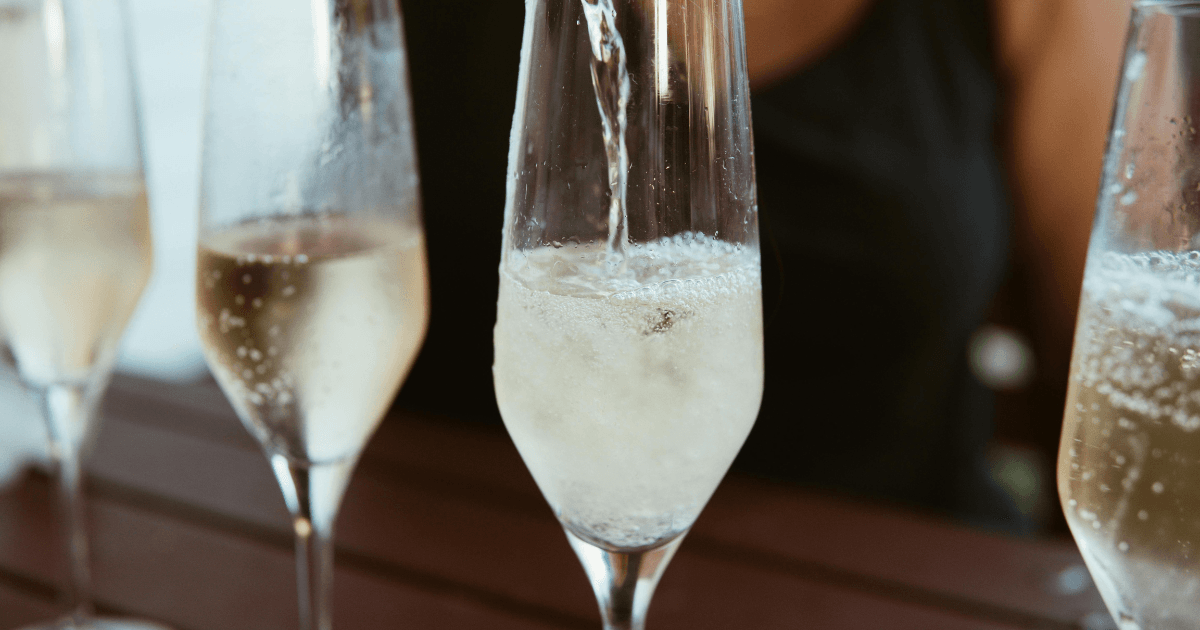
Ever wondered how many bubbles are in a single bottle of champagne? Around 49 million, if you’re counting. And they don’t just float—they spiral upwards at about 12 inches per second. Their paths are shaped by gravity, glass shape, and even sound vibrations.
Research into the behavior of champagne bubbles shows their movement and burst can vary by glass and pressure. There’s even been research into drinking champagne in space. Without gravity, bubbles wouldn’t rise at all—they’d form floating spheres of joy. The thought alone is worth raising a toast.
A Toast to Tiny Marvels
What we sip in champagne is more than effervescence—it’s centuries of refinement, science, and sensory wonder in every drop. Bubbles aren’t just pretty; they’re proof of process, of patience, of precision. Each trail of bubbles is a signature—an ode to the winemaker’s hand and the glassmaker’s curve.
They whisper stories of heritage while delivering notes of citrus, brioche, or honey to your nose and palate. They are fleeting, yet unforgettable. And when the time comes to mark your own moment of celebration—when you’re ready to turn sipping into ceremony—our sabers at California Champagne Sabers are ready to elevate the ritual. Because a bottle like this doesn’t just deserve to be opened. It deserves to be honored.
